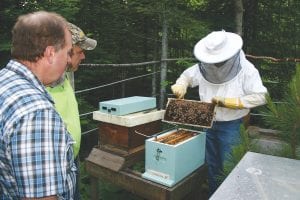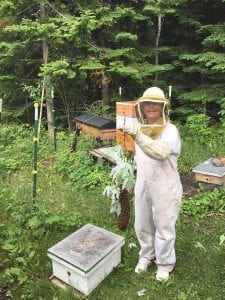Above: With Bill Wehseler and Jesse Derscheid (cap) looking on, Mark Ditmanson takes out a comb of bees to see how they were doing. There are about 20 beekeepers in Cook County, and they work together to ensure the health of the local honeybee population that originally came from Thunder Bay, Ontario.

Four Cook County beekeepers met Tuesday, July 18 at the Community Center and were all abuzz about the plight of bees in light of mites. Or in spite of mites.
It has been almost five years since Thunder Bay beekeeper Jeanette Momot sent out an emergency email to area beekeepers saying, “It has been a chaotic week.” She went on to say in that email that in the previous week, mites had been identified in an estimated 200 colonies of bees.
“Someone has brought in bees with mites, and we don’t know when or where.”
Mites brought on what became known as Colony Collapse Disorder, and it put a scare into bee keepers worldwide.
Local bee keeper Pastor Mark Ditmanson was one of those Cook County bee keepers notified by Momot. Today Ditmanson still keeps bees, and he keeps a close watch on them.
“They seem to be able to withstand the mites and other diseases. We are all very watchful for what develops the longer they are exposed to this threat,” Ditmanson said.

Left: Louise Reavis holds a “swarm” her husband David captured that was high up in a maple tree. Louise put the swarm into their new home, a bee box located in the Reavis bee yard.
Jesse Derscheid is a Grand Marais bee keeper. He was at the Tuesday meeting and asked if anyone had a queen to spare. “I have a drone layer now,” he said. “But no queen.”
David Reavis, a Hovland bee keeper, speculated that maybe a dragonfly took Jesse’s queen. Dragonflies are great at catching and eating bees. Mice can also be a problem. They sneak their way into a hive and steal honey. If the bees catch a mouse, they kill it and cover it with a film that makes a sarcophagus, said Bill Wehseler, which keeps the mouse from rotting and spreading illness through the colony.
Bears, of course, are the biggest problem. Most bee keepers put up electric fences to keep away bears.
If a hive gets too crowded, a swarm occurs when worker bees, drones, and usually the queen leave the colony to establish a new colony.
If that happens in early fall, bee keepers will try to find and catch the “swarm” and make a new bee box for them. Short of catching the swarm, those bees will most likely die because there is typically not enough food for them to eat so they can stay alive through the winter. Reavis had done just that, collecting a swarm from a nearby tree. This isn’t easy to do and can be dangerous.
According to Becky Keim, Center for Rural Affairs, “Over 70 percent of the world’s crop plants depend on pollination.”
Without bees, we would starve.
“Bees don’t hibernate— they survive by shivering all winter long. They do so with the purpose of generating heat to keep the cluster of nearly 20,000 to 30,000 bees alive, and most importantly, to keep the queen, who is at the center of the cluster, alive,” Ditmanson said.
If the winter is too long and cold, many bees die, he added. Some beekeepers insulate bee boxes to help the bees inside stay warm. Some bee keepers like Derscheid will feed them by buying honey and placing it inside the box during extreme cold periods.
Honey takes the taste of what the local colony has been eating. There is blueberry honey, apple honey, raspberry honey, tupelo honey, etc. “I have never tasted bad honey,” said Reavis.
“Our boreal honey is so clear it’s amazing,” Ditmanson added.
One of the reasons bees are making a comeback is because medicine to treat sick bees is not being used. Instead, the bees that survived the mites were bred. The theory goes that the fittest and most resistant bees will produce baby bees who are also disease resistant, and that seems to be working, said Ditmanson.
How do bees know how to find their way home? “They face the direction they are flying and wiggle their tails in a figure eight. It’s like a dance. And they repeat the dance. It’s fascinating to watch,” said Wehseler.
Queens can fly five to six miles away when they are searching for mates. They mate once with drone bees and can lay as many as 200,000 eggs. Typically a queen bee will live up to three years, but Bill had one queen that lived five to six years.
A hive takes on the personality of the queen. If the queen is aggressive and angry, it’s best to replace that queen with one who is easy going and more reasonable. Each of the men spoke reverently about queens who were docile and sweet natured.
Worker bees fly only as far as needed. They work themselves to death for the colony, living on average three weeks, said Ditmanson.
When asked if anyone makes money raising bees there was a chorus of laughter.
“No, I collect enough honey to bottle and give as Christmas presents,” said Reavis.
The others do the same or use some honey for personal use.
The four men gave a summary of bee nomenclature. . Bees might abandon a colony because of disease or other reasons. When that happens, they are called an absconding swarm. A bee yard is known as an apiary and apiculture is the science and art of raising honey bees. . Beehives are rectangular boxes with movable frames that are used to house colonies of bees. Castes are the three types of bees that make up the adult population of a bee colony: workers, drone, and queen. . A drone is a male honey bee. . In the spring old bees dwindle, dying off. . When a daughter of a queen takes over, it is called supersedure. When the new queen starts laying eggs the old queen disappears.
If the bee keeper meeting was supposed to take place inside the Community Center, it never got there. Across the parking lot, Ditmanson pointed out a patch of honeysuckle. “That’s a good nectar producing plant,” he said as the crew walked over to check out the spot. Sure enough, Derscheid counted six honey bees working to collect nectar. Next, the guys walked back across the parking lot to explore more plants. “Look, Sedum Autumn Joy. They (bees) love that little yellow flowering plant,” Ditmanson said.
It was clear bee keeping was a labor of love to these gentlemen.
“In China, they have killed many of the bees with poisons. Today they use feather dusters to pollinate fruit trees. Talk about a lot of labor,” said Wehseler.
Better to save the bees and let the bees do the pollinating, suggested Ditmanson.


Loading Comments